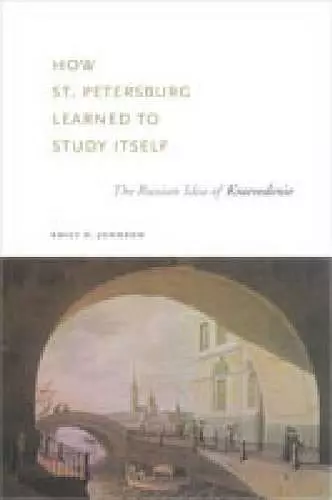How St. Petersburg Learned to Study Itself
The Russian Idea of Kraevedenie
Format:Hardback
Publisher:Pennsylvania State University Press
Published:6th Jun '06
Currently unavailable, and unfortunately no date known when it will be back
This hardback is available in another edition too:
- Paperback£29.95(9780271058658)

In the bookshops of present-day St. Petersburg, guidebooks abound. Both modern descriptions of Russia’s old imperial capital and lavish new editions of pre-Revolutionary texts sell well, primarily attracting an audience of local residents. Why do Russians read one- and two-hundred-year-old guidebooks to a city they already know well? In How St. Petersburg Learned to Study Itself, Emily Johnson traces the Russian fascination with local guides to the idea of kraevedenie.
Kraevedenie (local studies) is a disciplinary tradition that in Russia dates back to the early twentieth century. Practitioners of kraevedenie investigate local areas, study the ways human society and the environment affect each other, and decipher the semiotics of space. They deconstruct urban myths, analyze the conventions governing the depiction of specific regions and towns in works of art and literature, and dissect both outsider and insider perceptions of local population groups. Practitioners of kraevedenie helped develop and popularize the Russian guidebook as a literary form.
Johnson traces the history of kraevedenie, showing how St. Petersburg–based scholars and institutions have played a central role in the evolution of the discipline. Distinguished from obvious Western equivalents such as cultural geography and the German Heimatkunde by both its dramatic history and unique social significance, kraevedenie has, for close to a hundred years, served as a key forum for expressing concepts of regional and national identity within Russian culture.
How St. Petersburg Learned to Study Itself is published in collaboration with the Harriman Institute at Columbia University as part of its Studies of the Harriman Institute series.
“Johnson’s book provides a fascinating view of the cultural movements that developed in the early part of the twentieth century in St. Petersburg. As such, it is an important contribution to the growing number of recent works on the city.”
—Steven Maddox Canadian Journal of History
“Emily Johnson’s book is cogently written and very well researched; it deserves a wide readership not only in Russian studies but in comparative European studies as well. Her broad intellectual curiosity, focused through the lens of St. Petersburg’s cultural history, is both impressive and exemplary. This interdisciplinary study will have a wide resonance among those interested in local history, literary and cultural studies, and the history of nontraditional education.”
—James T. Andrews Journal of Modern History
“Johnson's scholarship is meticulous, and, in emphasizing the literary foundations of kraevedenie, her monograph will appeal to scholars of Russian literature and culture, as well as those interested in the complex and tortuous evolution of Russian civil society.”
—Michael F. Hamm The Russian Review
ISBN: 9780271028729
Dimensions: 229mm x 152mm x 21mm
Weight: 653g
320 pages